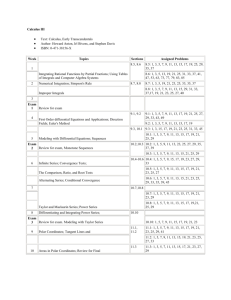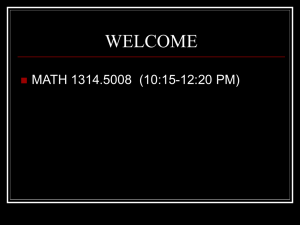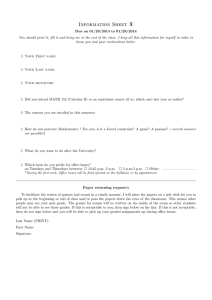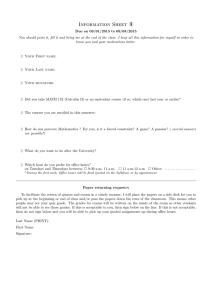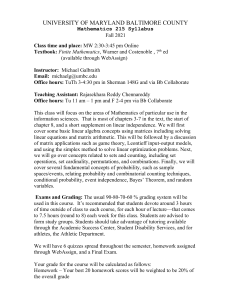Math 280
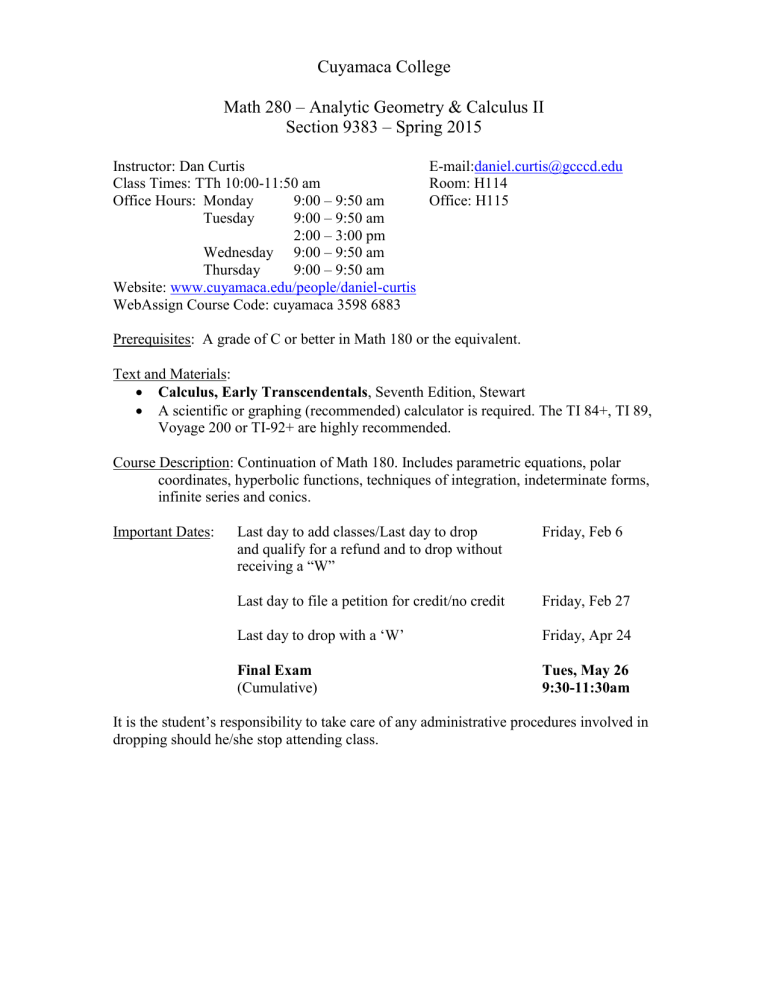
Cuyamaca College
Math 280 – Analytic Geometry & Calculus II
Section 9383 – Spring 2015
Instructor: Dan Curtis
Class Times: TTh 10:00-11:50 am
Office Hours: Monday
Tuesday
9:00 – 9:50 am
9:00 – 9:50 am
2:00 – 3:00 pm
E-mail: daniel.curtis@gcccd.edu
Room: H114
Office: H115
Wednesday 9:00 – 9:50 am
Thursday 9:00 – 9:50 am
Website: www.cuyamaca.edu/people/daniel-curtis
WebAssign Course Code: cuyamaca 3598 6883
Prerequisites: A grade of C or better in Math 180 or the equivalent.
Text and Materials:
Calculus, Early Transcendentals , Seventh Edition, Stewart
A scientific or graphing (recommended) calculator is required. The TI 84+, TI 89,
Voyage 200 or TI-92+ are highly recommended.
Course Description: Continuation of Math 180. Includes parametric equations, polar coordinates, hyperbolic functions, techniques of integration, indeterminate forms, infinite series and conics.
Important Dates: Last day to add classes/Last day to drop and qualify for a refund and to drop without receiving a “W”
Friday, Feb 6
Last day to file a petition for credit/no credit Friday, Feb 27
Last day to drop with a ‘W’
Final Exam
(Cumulative)
Friday, Apr 24
Tues, May 26
9:30-11:30am
It is the student’s responsibility to take care of any administrative procedures involved in dropping should he/she stop attending class.
Grading: Your final grade will be based on the percentage of total points you earned, using the following scale: A = 90% and above, B = 80-89.9%, C = 70-79.9%,
D = 60-69.9%, F = below 60%.
Grading Summary: Exams (3 @ 13% each): 39%
WebAssign Homework: 10%
Quizzes
Projects:
Final Exam:
Total
10%
15%
26%
100%
Exams: There will be three two-hour exams (each worth 13% each) during the semester.
Exam questions will be based on the homework, and I will review the material covered on the exam during class on the last class day before the exam. No makeup exams will be given, but if you contact me before the day of an exam, I may be able to make arrangements for an alternate time for you to take the exam. The final
(worth 26%) will be cumulative. Cell phones, or other communication devices, are not allowed on exams. Put them in your pocket or purse. If I catch you with one out,
I will take your exam away and you will only receive credit for what you have completed.
Homework: Homework assignments (worth 10% of your overall grade) will be completed using WebAssign and each section will be due one week after we cover it. Because the material from this course builds on itself, it is important to keep up with the homework assignments as they are due. You will have the opportunity to request extensions for an additional week to complete assignments, but any work done after the due date is penalized 50%. If you need an extension for a homework assignment, use the button provided in WebAssign and it will automatically be granted.
Quizzes: There will be a quiz on each topic we cover this semester. The quizzes will start at 10:00 am and will be collected at 10:10 am. Make sure you are on time. There will be no makeup quizzes. Quizzes will consist of a single problem and will be scored on a 2 point scale. You will receive the full 2 points if you get the problem correct, or make only a minor, non-calculus error. If you make a major error, or a calculus error, then you will receive 0 points. However, if you receive a 0, you will be allowed to redo the problem and turn it in at the next class. If your redo is correct, you will receive 1 point on the quiz. Your 2 lowest quiz scores will be dropped. The combined scores for your quizzes are worth 10% of your overall grade.
Projects: Throughout the semester, there will be projects due (worth 20% of your overall grade). The projects will consist of problems that are more interesting and involved than the typical homework and exam problems. Students are encouraged to work together, but each student is responsible for completing and submitting his/her own project.
Student Learning Outcomes
To successfully complete this course, students must demonstrate the ability to:
Use various techniques of integration to evaluate the antiderivative of a singlevariable function.
Apply numerical methods of integration including midpoint, trapezoidal and
Simpson’s rule and their relationship and order of errors to evaluate both proper and improper integrals.
Use integrals to represent a quantity of interest such as volume or total income by first examining a finite sum approximation of the quantity and then extrapolating to the limit (applications from geometry, economics, physics and probability).
Use the Mean Value Theorem and L’Hopital’s Rule to evaluate integrals and solve problems.
Apply Taylor and Fourier series as approximations of functions using simpler functions.
Use Geometric series to solve application problems.
Convert between polar and rectangular coordinates and use the area formula in polar coordinates.
Identify, manipulate and graph the standard and general forms of parabolas, ellipses and hyperbolas including translations and rotations.
Select and apply appropriate technology including but not limited to computer programs and graphing utilities to model, analyze and interpret a collection of data or to solve real-world application problems requiring the use of analytic geometry and calculus.
Attendance: Good attendance is a must for success in this class. College policy states that a student may be dropped from the course for excessive absences or tardies.
My Policy : Four absences during the first four weeks or six absences during the entire semester and you may be dropped – arriving significantly late or leaving significantly early counts as half an absence.
Disability Support Services: Academic accommodations are available for students with disabilities. Please identify yourself to your instructor and to DSPS staff so that the appropriate accommodations can be ensured. DSPS is at A-300, LRC (660-4239)
Academic Honesty: Academic dishonesty of any type by a student provides grounds for disciplinary action by the instructor or college. If you cheat, there will be consequences: I may give you a zero on the assignment or a zero in the course, or other additional consequences, regardless of whether you were the giver or receiver of the cheating.
Misconduct: Disruptive or threatening behavior or any conduct that interferes with my ability to teach or another student’s ability to learn will not be tolerated. Such actions could result in a warning, removal from the class, or referral to the Dean for disciplinary action. Please turn off your cell phones during class.
STEM Achievement Center: To support your efforts to succeed in this class, I refer you to the STEM Achievement Center (H-Building). The STEM Achievement Center is a resource center that provides individual assistance in mathematics and science.
Instructors and student tutors are available to answer homework questions, give confidence, and support math students. Students also have access to graphing calculators, textbooks, instructional videos, and computer tutorial programs.
Computers are also available for student use. The STEM Achievement Center is open Monday through Thursday 9:00 am - 4:00 pm, and Friday from 9:00 am to noon.
Class Schedule
Tuesday
Intro, 7.1
Thursday
7.1
Week
Wk 1 ( 1/26)
Wk 2 (2/2)
Wk 3 (2/9)
Wk 4 (2/18)
Wk 5 (2/23)
Wk 6 (3/2)
Wk 7 (3/9)
Wk 8 (3/16)
Wk 9 (3/30)
Wk 10 (4/6)
Wk 11 (4/13)
Wk 12 (4/20)
Wk 13 (4/27)
Wk 14 (5/4)
Wk 15 (5/11)
Wk 16 (5/18)
Finals Week
7.2
7.4
Review
7.8
10.2
10.3
Review
7.3
7.5
Exam #1
10.1
8.1
10.4
Exam #2
March 23-March 27
Spring Break
11.1
11.2
11.4
11.6
11.1
11.3
11.5
11.7
Review
11.8
11.10
6.3
Final Exam
Tues, May 27
9:30-11:30 am
Exam #3
11.10
6.2
Review for Final

